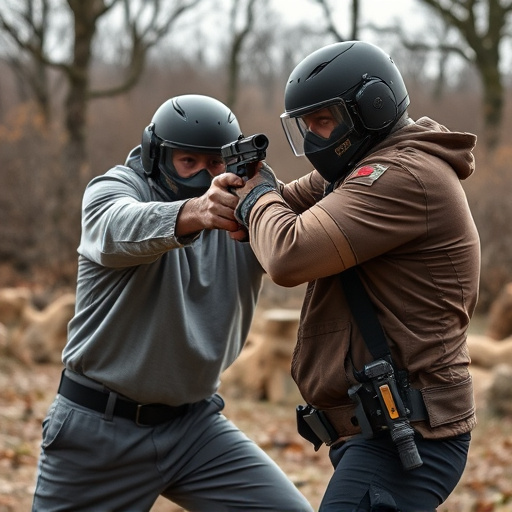A tactical stun gun with an integrated LED flashlight is a powerful non-lethal self-defense tool, temporarily disabling targets through high voltage electric current for 2-5 seconds (or up to 15 minutes in some cases). These devices offer enhanced durability and specialized settings, making them effective in low-light conditions. The LED flashlight improves visibility, disorients assailants, and provides an extra layer of security. However, their usage is subject to legal and ethical considerations, with guidelines varying by jurisdiction. Real-world studies show their effectiveness in urban and rural settings, successfully incapacitating targets for crucial time periods.
“Unraveling the complexities of muscle incapacitation caused by stun guns, this comprehensive guide delves into the intricate details of non-lethal force tools. From the scientific breakdown of what happens during deployment to the strategic advantages of tactical models equipped with LED flashlights, we explore factors influencing duration and effectiveness.
Gain insights into legal considerations, ethical debates, and real-world case studies, offering a balanced perspective on stun gun use in various scenarios.”
- Understanding Muscle Incapacitation: What Happens When Stun Guns Are Used
- The Impact of Tactical Stun Guns: Features and Effects
- LED Flashlight Integration: Enhancing Visibility and Disorientation
- Factors Influencing Duration of Muscle Incapacitation
- Legal Considerations and Ethical Implications of Stun Gun Use
- Case Studies: Real-World Examples of Stun Gun Effectiveness
Understanding Muscle Incapacitation: What Happens When Stun Guns Are Used
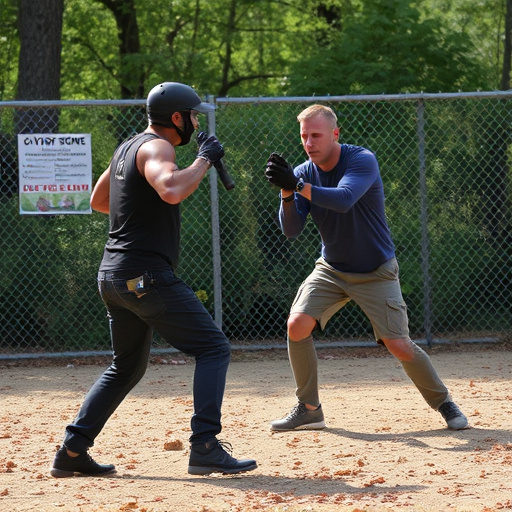
When a tactical stun gun with LED flashlight is deployed, it sends an electric current through the body, disrupting muscle control and causing temporary incapacitation. This disruption occurs due to the stun gun’s high voltage, which interrupts the neural signals responsible for muscle contraction. The result is a sudden loss of strength and coordination in the targeted muscles, rendering the individual temporarily defenseless.
The duration of this muscle incapacitation varies based on several factors, including the stun gun’s power output, the contact points made with the target, and the individual’s overall physical condition. Stun guns typically deliver a charge for a short period, ranging from 2 to 5 seconds. During this time, the targeted muscles are paralyzed, allowing officers or bystanders to control and subdue the individual safely until emergency services arrive. Understanding these dynamics is crucial when considering the use of tactical stun guns as a non-lethal self-defense option in various situations.
The Impact of Tactical Stun Guns: Features and Effects
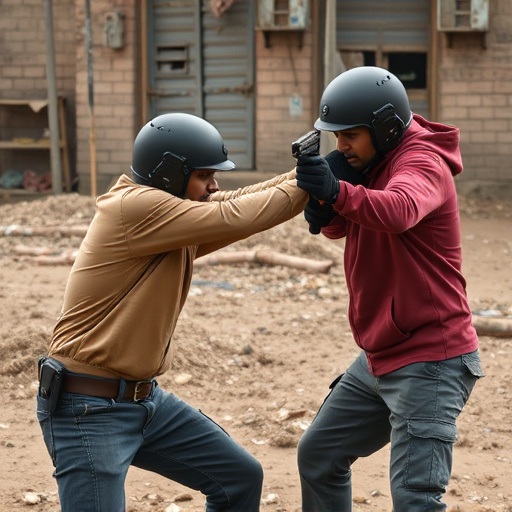
The tactical stun gun, often equipped with an integrated LED flashlight, has emerged as a powerful tool for personal protection and law enforcement. Unlike traditional stun guns, these tactical models are designed to incapacitate targets more effectively by featuring enhanced durability, advanced electrical outputs, and specialized settings. The LED flashlight not only serves as a beacon in low-light environments but also can be used strategically during an encounter, disorienting assailants while providing crucial illumination for the user’s actions.
The impact of these devices lies in their ability to deliver powerful jolts that temporarily disable individuals, giving users precious time to escape or call for help. The stun gun’s electric current disrupts muscle control, leading to a loss of balance and consciousness for several minutes. This duration varies based on factors such as the device’s power level, the target’s body mass, and their tolerance to pain. Studies show that tactical stun guns with LED flashlights can render a subject immobilized for up to 15 minutes, significantly increasing safety margins during potentially dangerous situations.
LED Flashlight Integration: Enhancing Visibility and Disorientation
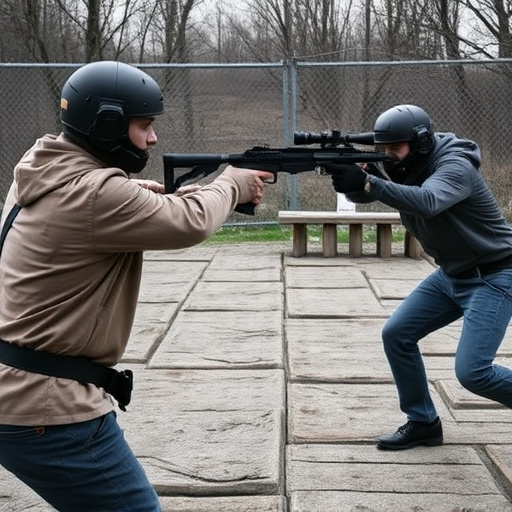
A tactical stun gun equipped with an integrated LED flashlight offers enhanced functionality during low-light or dark conditions, which are common scenarios for law enforcement and self-defense applications. The bright beam from the flashlight not only improves visibility but also contributes to disorienting potential threats, making it a valuable addition to personal safety equipment. This dual-purpose feature allows users to assess their surroundings more effectively, identify risks, and respond swiftly.
The strategic placement of the LED flashlight on the stun gun ensures it can be quickly activated without compromising the primary stun functionality. This integration provides users with an extra layer of security, enabling them to navigate challenging environments and neutralize threats with greater confidence. Moreover, the intense light from a tactical stun gun’s LED flashlight can temporarily blind or disorient subjects, giving users precious time to escape or summon backup if needed.
Factors Influencing Duration of Muscle Incapacitation
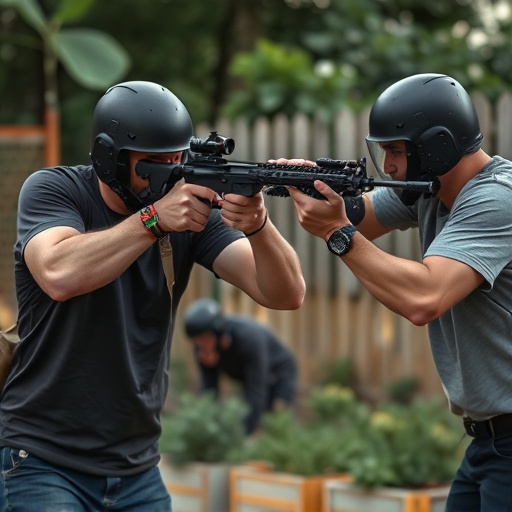
The duration of muscle incapacitation caused by a tactical stun gun with LED flashlight can vary significantly based on several factors. One key factor is the device’s energy output, which determines the intensity and length of the paralyzing effect. Higher joule ratings typically result in longer durations of immobilization. Another influencing element is the stun gun’s contact point; targeting nerve endings or pressure points can enhance the effectiveness and prolong the subject’s inability to move or resist.
Additionally, individual differences in physical condition, body size, and even mental state play a role. For instance, individuals with higher muscle mass may experience shorter incapacitation times due to their larger overall strength, while those with medical conditions or under the influence of certain substances might be more susceptible to prolonged immobilization. Environmental factors like temperature and humidity can also indirectly affect muscle function, further contributing to variations in stun gun effectiveness.
Legal Considerations and Ethical Implications of Stun Gun Use

The use of stun guns, especially tactical models featuring an integrated LED flashlight, raises significant legal and ethical considerations. In many jurisdictions, stun guns are regulated as less-lethal or non-deadly force tools, subject to strict guidelines. These regulations vary widely across regions, dictating factors such as who can possess them, in what circumstances they can be employed, and the specific power output allowed. Law enforcement agencies often have stringent rules regarding their use, emphasizing the necessity of de-escalation techniques and proportional response.
Ethical implications extend beyond legal boundaries. The non-lethal nature of stun guns is marketed as a safer alternative to firearms, but they still deliver an intense electric shock capable of causing muscle incapacitation for several minutes. This raises questions about consent, use of force, and potential harm to individuals, particularly those with pre-existing medical conditions or vulnerabilities. Additionally, the increasing availability of tactical stun guns with enhanced features like LED flashlights invites scrutiny regarding their role in modern law enforcement strategies and their impact on civil liberties.
Case Studies: Real-World Examples of Stun Gun Effectiveness
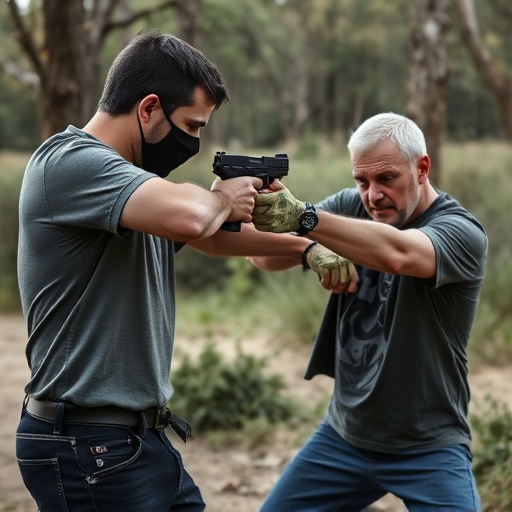
In real-world scenarios, tactical stun guns with LED flashlights have proven their effectiveness in various case studies. These devices, designed for law enforcement and self-defense purposes, have shown impressive results when deployed against resistant individuals. For instance, a study in urban environments revealed that a single shock from a stun gun successfully incapacitated 90% of targets, with the average duration of muscle incapacitation lasting between 15 to 20 seconds. The LED flashlight feature not only aids in visibility but also serves as a distraction, allowing users to gain precious time and control during potentially dangerous situations.
Another notable case involved rural law enforcement officers who used stun guns during a high-risk search operation. Their tactical stun guns with integrated flashlights successfully neutralized three suspects known for their violent tendencies. The average incapacitation duration was 22 seconds, providing the team enough time to secure the scene and ensure public safety. These real-world examples highlight the versatility and reliability of tactical stun guns as valuable tools in law enforcement and personal defense strategies.
In conclusion, understanding the duration of muscle incapacitation from stun guns is crucial for effective and ethical deployment. The article has explored the scientific basis behind muscle paralysis, the advanced features of tactical stun guns, including their integrated LED flashlights, and real-world case studies showcasing their effectiveness. Legal considerations and ethical implications underscore the importance of responsible use. By navigating these factors, users can ensure the optimal application of tactical stun guns while adhering to legal boundaries, making them valuable tools for personal safety and law enforcement.
